
















By David Porter
ew Zealanders will go to the polls on 14 October in what is predicted to be one of the closest nationwide elections in the country’s history.
The key concerns for Bay of Plenty businesses, according to our soundings, are that whoever wins the government should show strong leadership in such key areas as developing effective infrastructure to service the region’s continued growth.
Tauranga Priority One chief executive Nigel Tutt told Bay of Plenty Business News (BBN) that the Bay of Plenty had an important role to play in the country.
“But we lack the infrastructure to support that – we need to make sure politicians provide the infrastructure we need, and to support that infrastructure,” he said. “Obviously that helps ease congestion and frees up the need to spend all our time on travel.”
Polls narrowing
As we went to press, the most that could be said about the potential result was that the outcome was still uncertain, with polls on who might lead the country essentially showing the main parties were virtually level pegging.
Election polling has become increasingly sophisticated and accu-
rate in its predictions. But as often noted, in politics the only poll that really matters is the result on election day.
A Chinese friend of mine is currently one of many people who has been in jail without sentence for more than a year in Hong Kong – where I lived for many years – because of their protests against mainland China’s heavy-handed attempts to squash democracy in Hong Kong.
To reiterate a point I make in my opinion column this month, New Zealand media reflects a wide range of views and, compared to many countries, casting a vote here is easy and fair. So make sure your vote counts.
A recent Taxpayers’ Union – Curia poll report in the New Zealand Herald showed Labour crashing to below 30 per cent and National and Act with enough support, just, to form a government.
It also showed the public re-emergence of NZ First leader Winston Peters who elevated Labour to governing in 2017. NZ First showed up above five percent.
There are those who feel he lost much of his political mana when he sided with Labour, but Peters remains a long-time favourite of many in the Bay.
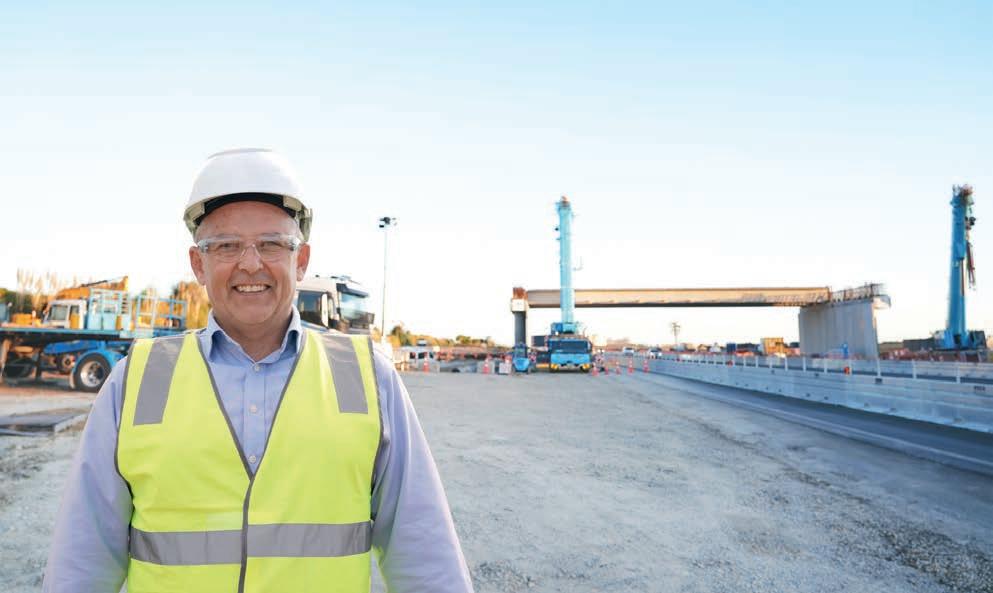
Seymour is generally seen to have done a good job in building what was basically a one seat party into a political force.
Any of these manoeuvrings might succeed and could deliver a very slim majority government to either Labour or National. Continued on page 5
The recent poll showed National up 1.6 percentage points from August to 34.9 per cent, while Labour was down 4 points to 27.1 per cent. Act was on 13 per cent and the Greens –where most of the Labour supporters appear to have moved after Labour ruled out the Greens’ proposed wealth tax, were up 3.1 points to 12 per cent. Te Pati Māori, which also supports Labour, was on 2.5 per cent. Both Peters and Act leader David Seymour were on 7 per cent in the leadership rankings.
funds $60M motorway interchange, providing much-needed infrastructure and regional benefit

Sir Paul Adams has been inducted into the NZ Business Hall of Fame.
The long-term Tauranga local was inducted before about 700 of his peers at a recent black-tie event in Auckland. It was a far cry from his childhood growing up in a state house in Upper Hutt.
Sir Paul is well known in New Zealand for his business acumen and his many philanthropic contributions, especially in the field of education. He told the Bay of Plenty Business News that he was especially pleased the actual award was presented to him by a Tauranga Boys’ College (TBC) student, Isaac Schuler.
“I requested a TBC student for the presentation and Isaac was selected for me,” he told BNN.
Sir Paul told BBN that TBS was a member of YES (Young Enterprise Scheme), which gives budding business students the chance to be involved in business enterprise during the school year.
He said that introducing inductees at the hall of fame event was an opportunity for those chosen to be exposed to New Zealand business people and to stand in front of the Governor-General and introduce inductees.
Community support
Contributions to the school include the gifting of Sir Paul and wife Cheryl’s former house to TBC

where it was relocated to the grounds and now serves as teacher accommodation and as a site for sports events.
Sir Paul said that he and his wife had also supported various students requiring financial support to take
part in overseas sporting, cultural and study trips.
Sir Paul originally worked at the Wellington Harbour Board engineer’s office to put himself through polytech and university in civil engineering and business manage-
ment. He built his reputation as an early pioneer in the kiwifruit industry and his long career has included being a prime mover in establishing the University of Waikato in Tauranga and founding the successful Carrus Corp construction company.
Although a regular and generous contributor to the community, he generally maintains a low profile.
His achievements include his knighthood for services to philanthropy and the community and being named a Companion of the New Zealand Order of Merit for services to business and philanthropy.
Sir Paul has held numerous roles including as a director of the IHC and the founding chairman of large social housing non-governmental organisation Accessible Properties, owned by the IHC.
He was a past councillor of Waikato University, the Waipuna Hospice patron and life member, the founding director and a life member of the Western Bay of Plenty economic agency Priority One and patron of Tē Tuinga Whānau Support Services Trust.
He was reported as being “truly humbled and honoured” to be acknowledged and welcomed into the ranks of fellow businessmen and women who had all made extraordinary contributions to business and the community in New Zealand.
Chartered Accountants Australia and New Zealand (CA ANZ) welcomes the Government’s announcement of mandatory financial literacy education in schools, saying it will help address an essential skills gap that threatens New Zealanders’ economic well-being.
While CA ANZ welcomes the announcement and applauds the cross-party focus on the issue, the peak accounting body is concerned by the reduction in accounting content offered in the secondary school curriculum and the significant decline in tertiary accounting degree enrolments since 2018.
“Secondary students have less exposure to core accounting with the new NCEA curriculum, and that’s affecting tertiary enrolments. Demand for accounting and finance professionals is outstripping supply and New Zealand businesses and the economy more broadly can’t afford for our education system to be a handbrake.
“While the latest enrolment figures are good for employers, without improvement in the key settings for university funding and the secondary school curriculum, we will struggle to deliver the pipeline of accounting and finance talent that New Zealand needs to compete on a global stage, even with changes to our program,” said CA ANZ NZ Country Head Peter Vial FCA. “The Government introduced mandatory climate-related disclosures for certain large entities this year, and accountants will play a critical role in businesses complying with the new requirements. Yet the Government has significantly reduced the scope of accounting at NCEA Level 1 limiting students’ ability to gain exposure to the subject early in their education.
“The impacts of this change will be seen in five years’ time, where there will likely be a critical supply shortage of accountants graduating into the workforce. We have an opportunity to prevent this from happening in the finance and business sector.








www.bopbusinessnews.co.nz
CONTACT INFORMATION
PUBLISHER
Alan Neben, Ph: 021 733 536
Email: alan@bopbusinessnews.co.nz
EDITORIAL
Alan Neben, Ph: 021 733 536
Email: editor@bopbusinessnews.co.nz
PRODUCTION – Copy/Proofs/Graphic Design
Times Media – Clare McGillivray
Email: clare@times.co.nz
ADVERTISING
Pete Wales, Mob: 022 495 9248
Email: pete@bopbusinessnews.co.nz
ELECTRONIC FORWARDING
EDITORIAL: News releases/Photos/Letters: editor@bopbusinessnews.co.nz
GENERAL INQUIRIES: info@bopbusinessnews.co.nz
Bay of Plenty Business News has a circulation of 8000, distributed throughout Bay of Plenty between Waihi and Opotiki including Rotorua and Taupo, and to a subscription base. www.bopbusinessnews.co.nz
Bay of Plenty Business Publications
309/424 Maunganui Rd, Mt Maunganui, 3116
Bay of Plenty Business Publications specialises in business publishing, advertising, design, print and electronic media services.

As I began researching this month’s cover story on our upcoming polls (see pages 1 and 5), I reflected on how lucky New Zealanders are with our elections.
We are blessed with a wide variety of media that reflect a range of dissenting views. Voting is as easy as going to your nearest polling booth. Providing you are registered and all is in order, you tick a box, the votes are taken away and fairly counted. And after the nationwide result is declared there is rarely any dispute over the legality of the outcome.
But in China, becoming paramount leader of 1.6 billion people involves a high degree of intelligence, considerable ingenuity, and a sophisticated grasp of adept political manouevring we can barely comprehend.
total trade, including $21.39 billion in exports – largely dairy, meat, and wood products – and $18.93 billion in imports, led by machinery and vehicles.
I first visited China back in the days of its early very controlled “opening” to the outside world. Beijing, the capital of what was then the world’s most populous country, slumbered at night. There was little public lighting and few cars. You could have been in a rural backwater. The predominant sound of the evening was the sibilant rubber hissing of millions of bicycle tyres as residents pedalled their way home.
revealed that for the first time since China’s economic liberalisation, the working age cohort has been decreasing. According to UN estimates this group will continue to contract, dropping to 773 million by 2050. The under14 population will also fall over the same period. And nobody is expected to replace them.
In other words, formerly positive projections for growth are now going the other way with deaths outnumbering births last year for the first time since 1961, according to recent reports.
Of course, that has all changed. Automotive industry production in China has been the biggest in the world since 2008 and now the streets are jammed with cars. But the issue for Deng Xiaoping and his leadership successors since has basically been a trade-off - keep the growing young population satisfied and undemanding by guaranteeing steadily increasing GDP growth and a more prosperous life.

In case you missed last month’s edition Scan to subscribe

Chinese president Xi Jinping and his predecessors have benefited hugely from their tightly controlled management of information, and a largely compliant media. Which is not to understate the political nous required to lead such a large nation. But that may all soon change as demographics – so long favourable to China’s leadership – takes a turn downward. And this is key to New Zealand’s future prosperity as China assumes the role of our biggest trading partner with around NZ$40.32 billion in


But now the “Chinese century” is over, according to a report in online magazine Salon. Several publications have noted that what was, for previous decades, China’s key advantage — its never-ending supply of working-age labourers — peaked at almost 1 billion people in 2010.
But the next census, in 2020,
The fertility rate, which should be at 2.1 children per adult woman just to maintain a steady population, has slipped below 1.1. And China is a long way from gender equality as a result of male favouritism and its only recently abandoned onechild family policy. Experts suggest that the long-term outcome is that 10s of millions of men will never start their own families.
The demand for investment properties has been so high that China’s construction eruption simply cannot be reasonably compared to those property bubbles that have occurred in any other major economy. According to a Reserve Bank of Australia graphic residential gross fixed capital as a proportion of GDP is close to 20 percent in China — the comparable proportions in Australia, Japan, South Korea and the US are around five per-











cent or less.
As well, GDP is essentially declining. According to recent reports, the Chinese economy, if measured by anything remotely approaching accuracy, won’t surpass that in the US because it simply cannot. Also bear in mind that Chinese statistics are regularly fudged. As I learnt from many years of reporting on China, the leadership tends to tell its bureaucrats what it wants its GDP growth to be and then triumphantly announces that the target has been achieved.

“The structural forces that have allowed it to grow at breakneck speed for half a century are now the same forces preventing it from continuing to do so,” notes Salon.
I can only urge my fellow Kiwis to take advantage of what we have and get out in October to make your vote count.




From page 1
What are our options?
So in one corner we have the governing Labour Party, led by Chris Hipkins, an experienced member of parliament and debater. And in the other the National Party, led by relative political neophyte Christopher Luxton, an experienced former senior businessperson who is beginning to find his feet as a politician.
There was some enthusiasm in the reported opinions of New Zealand’s political pundits when Jacinda Ardern stepped down slightly earlier than expected at the beginning of this year. The plaudits basically praised her smooth transfer of power without incident to Hipkins.
The reality is that Ardern was the best leader Labour has had for many years. She was astute enough to read that the popularity polls were heading away from the party and knew it was time to pull the plug.
But simply ensuring Hipkins had been front and centre for months of the generous allocation of blanket Covid-19 advertising, did not in itself make him a leader. Indeed, passing on the Labour leadership to Hipkins could be seen as a poisoned chalice.
After all Hipkins has been at the centre of Labour policymaking for years. To differentiate himself from Ardern and put a new face on Labour he was obliged to perform an undignified U-turn and attempt to walk back from several key Labour policies that were now proving unpopular. The vagaries of MMP politics
ACT is expected to side with National if it is needed to topple Labour. As well, thanks to Labour’s significant recent past political success, they have a number of unelected List MPs, a quirk of the MMP List system. Obviously, failure to deliver a large nationwide party vote could cripple any party’s chances of governing.
For example Jan Tinetti, a long-term local resident and former school principal who is currently Labour’s education minister, has been granted a high place on the List, so will make it back into Parliament assuming voters turn out for Labour. But she will also again attempt to win a candidate’s seat in Tauranga.
In Rotorua, long serving
National MP Todd McLay will again stand, and Tamati Coffey, who had been planning to retire from politics, has been offered the chance to succeed Kiri Allen in East Coast, who is one of several senior MPs who have been obliged to leave the Labour Party’s front benches for various breaches of Parliamentary behaviour.
Major political changes in the Bay
This is a good point to thank Todd Muller for his lengthy service to the Bay of Plenty. As is well known, he tilted for the National leadership and won from then Tauranga MP Simon Bridges, only to resign soon after.
As a result of going through that process he has provided valuable exposure of the mental health challenges of serving in Parliament. He has made it clear that his several years in Wellington were enough and that his family requires more of his concentrated time.
Muller was generally regarded as a very capable MP who knew his briefs and worked well with colleagues on all sides of the House. As he noted in his recent valedictory address to Parliament, a copy of which he passed on to me, Muller began by thanking his wife Michelle for her support during what had not been “the smoothest of rides”.
He added that it had been a
genuine honour to represent the Bay community he had lived amongst for 50 years.
Amongst other remarks, Muller, a long-term advocate of the need to face the challenges of climate change, noted New Zealand would bear significant costs in attempting to adapt to it over time.
“We must reduce our gross emissions and seek efficient ways to offset them in the short-term,” he told Parliament.
His role as the National candidate for Bay of Plenty has been taken by Tom Rutherford.
Rutherford told BBN that National was focusing its campaign on “the three c’s – the cost of living and the need to get inflation under control, reducing crime, and congestion.
“Congestion is limiting our ability to get around our community and is stifling at the moment,” he said. “We need to do something about our transport and roading networks. We’re one of the largest cities in the country and we need to support that. There’s a mood for change.”
Rutherford said the biggest problem was how to go about unwinding the damage that has happened, while putting forward policies to go forward.
“It will be a big challenge and there’ll be a lot of work,” he said. “We must have a realistic expectation that things will take time.”
Sam Uffindell, who replaced Bridges in Tauranga, also told BBN National would be focused on the economy, reducing the cost of living, improving infrastructure, restoring law and order, and on improving schools and education.
“Those are the main issues voters are concerned about and the main challenges voters face at the moment,” he said.
”We have to just keep working hard on the things that matter to voters and gaining trust.”
Rising costs of doing business
There are a range of pressing issues, but long-term, the key economic issue is re-balancing our trade defi cit.” – Matt Cowley, Tauranga Business Chamber chief executive

“A key future focus needs to be improving New Zealand’s economic productivity. Businesses will need to innovate and focus on research and development to stay competitive in a world facing skills shortages, artificial intelligence, deglobalisation, and climate change.”
Priority One’s Nigel Tutt adds: “I think the challenge is that the New Zealand economy has become less and less affordable. Certainly National has shown its intent in their policies and I guess other parties will need to follow suit.
The award-winning TECT Park is now more than 10 years old and to celebrate, they’re looking to see what new activities and experiences could be added to the park.
They’re seeking fresh ideas to help TECT Park enter an exciting new phase.
The 1650-hectare site, jointly owned by Western Bay of Plenty District Council and Tauranga City Council, is located about halfway between Tauranga and Rotorua.
It is the home of the Adrenalin Forest high-wire adventure course as well as many outdoor activities including tracks for walking, mountain biking, horse riding and a dog exercise area.
Onsite club activities include shooting ranges, motorsport tracks, and model aircraft flying fields.
More than 30,000 people visit the park each year, and they’re looking to see what new experiences could be added to help boost these numbers.
Everyone who provides their ideas will go in the draw to win exciting prizes like a mountain bike voucher, Adrenalin Forest passes, and Stoney Creek vouchers – perfect to use at TECT Park.
Western Bay of Plenty District Council general manager infrastructure group, Cedric Crow says the park continues to evolve with sustainability, education, and cultural significance, key to the park’s future, along with providing for the many clubs and user groups.
“This park is a great example of what is possible when we work in partnership with Tauranga City Council and our community.
“We’re excited to hear from our community on what else they would like established or to experience at the park, as this will help guide our thinking to shape the park’s future direction.”
Tauranga City Council spaces and places manager Alison Law says TECT Park is entering an exciting new phase.
“TECT Park is a real local asset for those who love the outdoors, or those looking for a new hobby or challenge outside of their comfort zone.
“Since it opened, we’ve seen TECT Park grow with what it can offer, and this will continue in the coming years.”
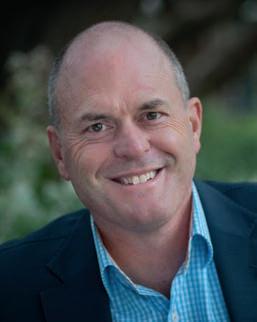
According to Matt Cowley, chief executive of the Tauranga Business Chamber, the common issues experienced by Chambers across New Zealand are the rising costs of doing business, the tight labour market, and the shortage of infrastructure needed to address the housing and transport issues.

“There are a range of pressing issues, but long-term, the key economic issue is re-balancing our trade deficit where New Zealand is importing more than we’re exporting,” Cowley told BBN.
“Any party with a long-term plan for infrastructure is going to find it beneficial for voting support,” he said. Tutt added that while he understood the government’s approach towards growing centralisation, that policy approach made it harder to operate at regional level as well.
“As a growing region we should have the ear of government and the response of government,” he said. “We need to have that long-term agreed infrastructure plan. The reality is that politicians don’t manage infrastructure very well.”

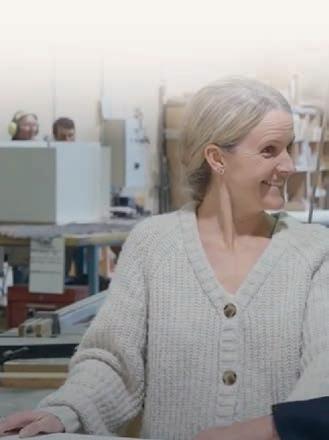
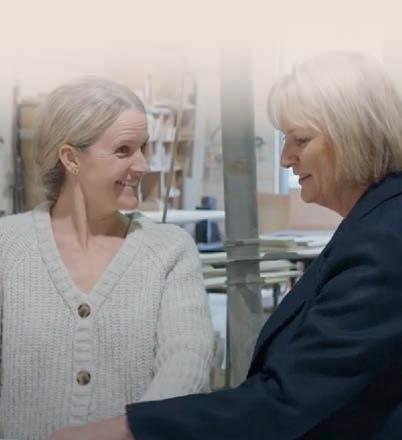






A review of traffic management processes is expected to reduce the impacts of the ongoing Cameron Road upgrade on businesses along this key arterial route.
By ANNE TOLLEY, Tauranga Commission Chair
This hugely significant project is the first stage of a work programme designed to futureproof the Cameron Road corridor to ensure that it can cater for housing intensification along the Te Papa peninsula, where the population is expected to grow by around 15,000 people over the next 30 years.
Stage One of the ‘Building our future’ Cameron Road project, between Harington Street and 17th Avenue, is part-funded by a $48 million Government grant and involves intersection safety improvements; safe crossing points for pedestrians; the creation of bus clearway lanes in both directions (with the lanes available for parking outside of the morning and afternoon traffic peak periods); construction of grade-separated cycleways and footpaths; placemaking upgrades to gardens and greenspaces; and the renewal and upsizing of ageing underground services (water, waste-

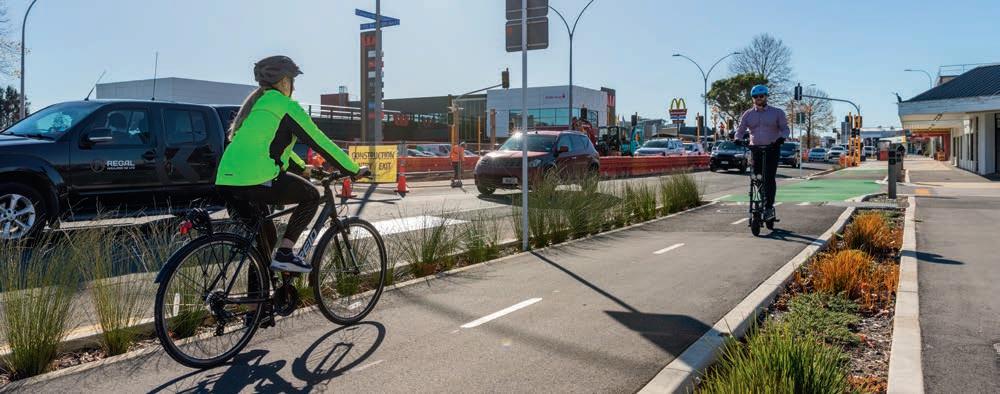

water and stormwater assets).
The project has been underway for some 18 months now and is expected to be completed by the end of 2023.
Major roadworks like this are inevitably disruptive, but a number of factors have resulted in impacts on the businesses that rely on access to and from Cameron Road for their customers and staff.
We asked the joint venture contractor to conduct a thorough review of the construction elements of the project, particularly focusing on the use of traffic manage-
ment infrastructure (mainly the large, orange water-filled barriers that channel traffic and pedestrians away from worksites), with a view to identifying solutions that will help to ease the problems businesses along the work zones have been experiencing.
As a result, rather than leaving traffic management equipment in place when work is delayed for some reason, this is being removed and a temporary surface provided if the delay is expected to extend for a week or longer. And rather than use the barriers all of the time, the JV is using other, less-disruptive equipment when it can safely do so.
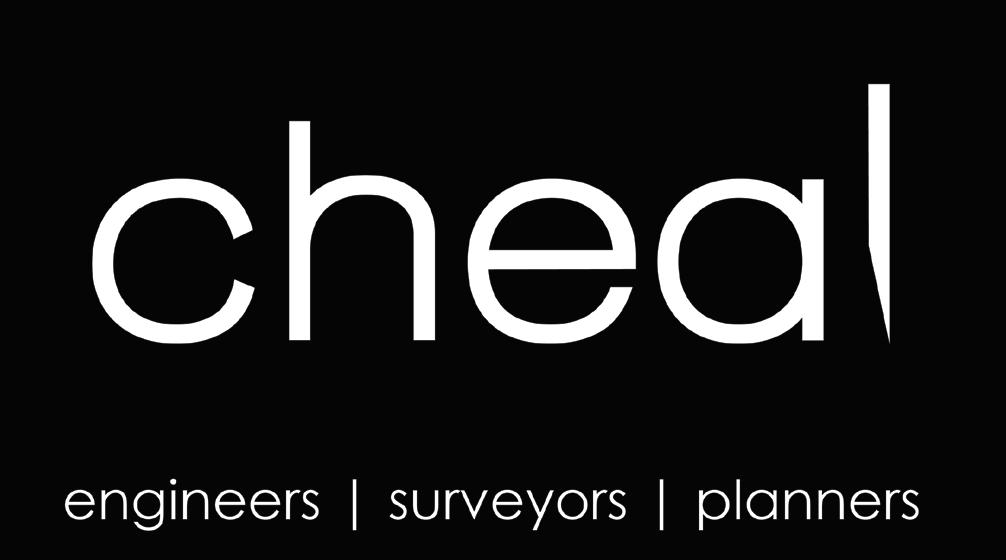
Proudly providing expert advice and adding value to projects across the Bay of Plenty since 1940.
To experience Cheal’s award winning service,
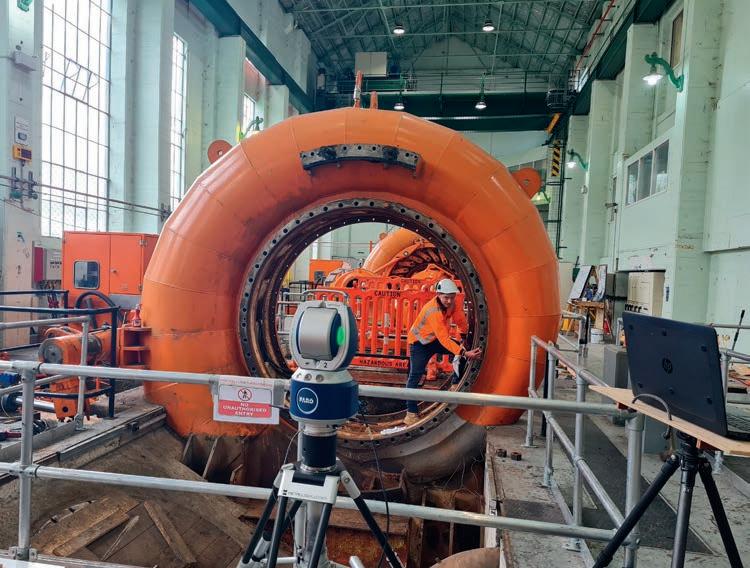
Apart from intersection safety, improved pedestrian crossing points, peak travel time bus clearways and renewed underground services, the Building our Future Cameron Road project also provides gradeseparated cycleways and walkways and signifi cant garden areas.
A procedure has also been put in place to assess the likelihood of delays before worksite establishment begins in new areas, to ensure that there is no equipment-related disruption until it is absolutely necessary.
Council’s project managers are meeting with the JV on a regular basis to monitor
progress and any issues that are arising and there is a joint commitment to being more agile in addressing stakeholder impacts through to the project’s completion.
In addition to the above steps, Council has initiated an external review of the entire project, so that we can use the learnings provided to avoid
unnecessary issues with future major infrastructure projects, such as Cameron Road Stage 2 and the planned 15th Ave/ Turret Road upgrade. In the meantime, the Council and the Commission want to thank Cameron Road businesses and road users for their patience while this transformational project is completed.
Harvey is a well known community advocate and business owner in Tauranga. Following a corporate background, Erika
transferred her skill set into community advocacy and helping others. The General Manager for a local youth charity, she is dedicated to ensuring equitable access to education and wrap-around services for children and youth.
Alongside her current tenures, Erika has also been on various community boards and working groups, including with Tauranga City Council, Bay of Plenty District Health Board, and as former Chairperson of Greerton Village School.
An American-born New Zealander, Erika has made Tauranga her home for almost 15 years and is intent on giving her community a stronger voice in parliament and returning Tauranga to democracy with a local body election in 2024. Her work in local government issues as an affected business owner have inspired her to further advocate for her community by standing for New Zealand First.
Erika lives locally with husband Dan, and their two children, 12 year old Piper and newbaby Ziggy.











> BY JACOB DOHERTY
Jacob Doherty is an account manager at Stratus Blue. He can be contacted at jacob@stratusblue.co.nz
echnology continually evolves, and with each year that passes, technology evolves faster and further. In 2023, topics like artificial intelligence, cybersecurity and augmented reality seem to dominate the technology conversation, but all of these areas are underpinned by the location and availability of the data which feeds them. That’s probably a reasonable definition of ‘Cloud’: the topic of this article.
Cloud, or Cloud Computing, is defined similarly by Amazon and Microsoft. Amazon talks about cloud being “the on-demand delivery of IT resources over the Internet with pay-as-you-go pricing”, meaning that “instead of buying, owning, and maintaining physical datacentres and servers, you can access technology services on an as-needed basis.”
Microsoft refers to “the delivery of computing services — including servers, storage, databases, networking, software, analytics, and intelligence — over the internet to offer faster innovation, flexible resources, and economies of scale.”
So, from the start, there were some clear, tangible benefits to being ‘in the cloud’.
Cost savings, reduced downtime, and the access to enterprise level technologies at SMB level pricing. In 2013 Microsoft’s cloud services (Office 365 and Azure) and Amazon’s Web Services (AWS) were leading the way.
Microsoft introduced what it called a ‘paradigm shift’ by allowing its users to access their emails, documents, and applications from any device with an internet connection.
AWS marked the start of the scalable, consumption model, offering businesses the (at the time) unique opportunity to rent computing power rather than investing in expensive infrastructure.
Where organisations were always needing to budget for a 3-5 year CAPEX spend on a new server, and then have to cool that server, maintain it, deal with downtime and interruptions and manage its security themselves, there was now an option to outsource all of that.
As time went on, offerings developed – more of the applications which are commonplace in New Zealand and global businesses alike –Salesforce, SAP, MYOB and Google’s Cloud (not the search engine, but emails and storage for business) – along with cloud-born programs like HubSpot for marketers and Xero for invoicing, became widely available.
Organisations started to become familiar with ‘cloudready’ software, which just needed a place to live (not the server in a corner of the office anymore), rather than complicated, time-consuming, costly customisation and development before they were ready.
Cloud pricing models remain attractive to organ-
isations, but they too have evolved, with best practice now incorporating cloud with value-add services in a per user, or per organisation, monthly price, allowing businesses to access everything they need to operate effectively while retaining the flat cost line month on month.
These models – often referred to being ‘as a Service’ – will include the platform, or the software, or the infrastructure, or a combination, that your organisation needs, along with support, maintenance and additional innovation.
On the theme of innovation, it is worth recognising how cloud has helped silo skillsets to allow people to focus on what they do best.
Where previously developers would have to be concerned about the thresholds or limitations of the environment they were developing in, they can now focus solely on code, leaving infrastructure management to those who specialise.
In ten years, cloud has evolved from basic email services being taken off the server in the office to advanced AI-driven analytics, machine learning and decision assistance focused on summarising the information that people need to see.
As technology evolves and demands shift, the cloud will undoubtedly adapt further, continuing to revolutionise the way in which we do business and enabling new possibilities that hadn’t even been considered just a decade ago.

> BY BRIDGET SNELLING
Bridget Snelling is the Xero Country Manager for New Zealand
s recession continues to impact the country, small businesses in the Bay of Plenty and across Aotearoa New Zealand face the consequences of slow sales growth, high inflation, and less consumer spending.
As the pressure from these issues grows, cash flow management has never been more important.
With challenging market conditions, small business owners are struggling to manage finances – often causing personal stresses at home.
The key to navigating through uncertain times starts with knowing your numbers. Remaining up close and personal with your cash flow allows you to focus on making better, well-informed decisions for your business.
But above all, it allows you to manage your wellbeing more effectively. A recent Xero report found 15% of small businesses in New Zealand said work issues caused personal stress most or all of the time.
Cash flow issues are a systemic and volatile cycle, which see business owners dipping into their own personal savings, working unattainable hours, and ultimately sacrificing their emotional and physical wellbeing to stay afloat.
In this recession, high inflation is also a major factor, with price hikes affecting every part of the economy. For many businesses, this means higher supply costs.
Almost half (48%) of small businesses said inflation had eroded their cash flow in 2023, and in the 12 months to June, 55% of small

businesses experienced cash flow issues, with 18% experiencing “significant” cash flow problems.
Cash flow management takes an emotional and physical toll on business owners.
A total of 80% of company owners surveyed by Xero said they were stressed about cash flow, 60% said they had trouble sleeping, and 47% had lost time with friends and family.
Thousands of Kiwi small businesses fold each year. More often than not, it’s because they’re unable to overcome cash flow issues.
During these challenging economic times, it’s important small business owners understand what their cash flow needs are and what they can do to get paid faster.
Digital tools are the key to effectively managing cash flow. They help you understand exactly how your business is performing, putting you in a position to make more informed decisions.
They flag when cash flow is due to be low, allowing you to prepare for the squeeze
and push for more work. They also reveal when cash flow will be strong, allowing savvy business owners to take calculated risks and make the most of opportunities that arise during these periods. It’s time for business owners to take matters into their own hands and embrace the support available to them. Whether that’s using platforms like Xero Analytics Plus, which lets you avoid losses by calling for prompt payment upon completion of a job, or Xero’s Assistance Programme, which offers free access to face-to-face, online chat, and phone counselling. Small businesses should also consider registering their interest for eInvoicing, a technology which will help improve payment times by greatly increasing accuracy and security while reducing human errors.
By taking control of your cash flow, and knowing your numbers, you give yourself the best possible chance to navigate tough times and come out the other side better off.

The Rangiuru Business Park is set to be a modern, future-focused, and high-quality industrial business park that supports the liveability and prosperity of the people and the region for generations to come.
Nestled in the heart of the Bay, within the ‘Golden Triangle’, it is conveniently located 30kms from the Port of Tauranga, connected by road, rail and sea.
It boasts 148 hectares of consented industrial land, to be developed over four stages. Bulk infrastructure to service the Park began in 2022, with major works underway including earthworks, civil, wastewater rising main to Te Puke, water reservoirs, a stormwater pond, power, fibre connectivity and upgrades to nearby roads.
These works will service the Park and also provide futureproofing to the area for continued regional growth.
Right on the doorstep is the Tauranga Eastern Link Toll Road (TELTR), to be connected by a motorway interchange which commenced in October 2022.
In late August 2023, the development hit another significant milestone, with the installation of eight large beams, each 33.1m in length and weighing approximately 65T, fixed onto columns straddling the TELTR.
This is a key piece of infrastructure that will link the Park to the motorway and the wider region – a visual signifier of the notable progress for the project.
The interchange is expected to be open in late 2024.
As the lead developer for the Rangiuru Business Park, Quayside has owned and funded this approximately $60M interchange build to date, following an initial $18M contribution
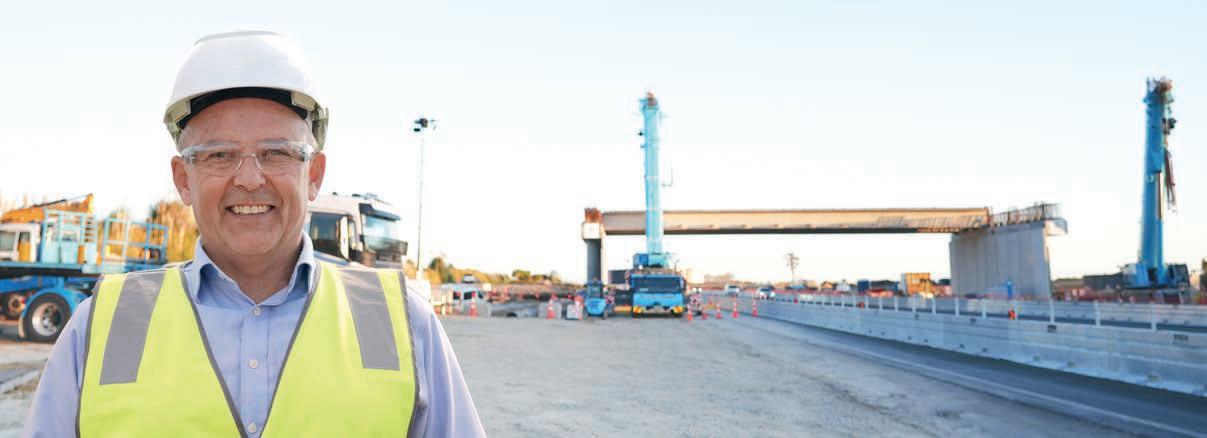
from the Provincial Growth Fund (PGF) in 2020. This provided the seed capital to start the motorway interchange, a vital piece of infrastructure and considerable investment into the region.
“The overall vision for the Park will contribute significantly to the region. As such, we have invested heavily into infrastructure, such as the interchange, which will have longterm regional benefits for our rohe” says Lyndon Settle, Quayside CEO.
Recent studies have shown that industrial land is constrained in the BOP, with Tauriko and Mount Maunganui at capacity, new sites are needed to cater for the expected longterm future growth of the region.
“The Western Bay of Plenty is a popular place for businesses to locate themselves, and we have seen strong growth in our local business community in recent years.
“Industrial land is sought after to meet future demand and to provide additional choice for developers and businesses. The location of Rangiuru means it is well served to cater to demand on the Eastern side of our city,” says Priority One chief executive Nigel Tutt.
Once completed the Park will provide up to an estimated 4,000 permanent, full-time employment opportunities in the region, in addition to the 200 jobs per year created during construction stages.

Quayside Holdings GM Property, Michael Jefferies says “This development meets the shortfall in high-quality industrial land close to the Port of Tauranga. The proximity and established multimodal transport links providing wider regional accessibility between Tauranga, Whakatāne, Te Puke, Kawerau and Rotorua offer huge opportunities”.
The Park is being developed in consideration and support of regional growth strategies (SmartGrowth, Future Development Strategy, Tauranga Transport Plan, Tauranga Urban Strategy, Bay of Connections Growth Strategy, UFTI, etc), in addition to the needs of local businesses, expanding communities.
Lyndon Settle, Quayside CEO said, “The role of Central Government investment into our region’s core infrastructure, plays a critical role in unlocking the Bay of Plenty’s economic potential.
“ Quayside is responsible for growing a diversified fund that generates long-term returns that support the prosperity of the BOP. Rangiuru Business Park will play an important role in enabling economic growth across this region.”
The Rangiuru Business Park is majority-owned by Quayside Properties Limited, a wholly owned subsidiary of Quayside Holdings Limited, the investment arm of Toi Moana Bay of Plenty Regional Council.
Latest 2degrees study conducted by Perceptive, reveals the key issues facing NZ business decision makers, and how thriving companies are weathering the storm.
Good news – businesses say they are seeing ‘green shoots’ and are optimistic about the year ahead.
2degrees surveyed 700 business decision makers nationwide as part of it’s Shaping Business Study, now in its fourth year, and found business is shifting focus completely away from the pandemic and towards managing rising costs and improving productivity.
Andrew Fairgray, Chief Business Officer at 2degrees, says this year’s report doesn’t feature any regional trends. “Interestingly, businesses across the regions are reporting the same things – which is a marked change from previous years where business sentiment varied by region.”
Bay of Plenty businesses, and their counterparts nationwide, said:
• Business optimism continues to trend slightly upward despite the recessionary pressure.
• Cost and pricing continues to be front of mind for business leaders.
• Larger businesses continue to thrive while smaller businesses are more likely to be struggling.
• Staff and productive use of tech-
nology are the make or break for businesses in 2023.
The report, revealed that 87% of businesses have seen their running costs increase in the past twelve months, yet only 63% had increased their prices over the same time, suggesting that many businesses are having to absorb inflationary impacts.
Fairgray says the report shows that while the pandemic may be in the rearview, the business outlook is still filled with challenges.
“This is the second straight year that we’re seeing cost increases across the board for businesses, but the impacts of that aren’t being felt equally.
“What we see in the market and in this report is that the businesses who can thrive in this environment are those who can find innovative ways to increase productivity, whether that’s through attracting and retaining great staff or making more effective use of digital tools.”
As the economy gets to grips with a new set of challenges, businesses are moving from just getting by to a more measured outlook. This year, the number of business leaders who said they were surviv-
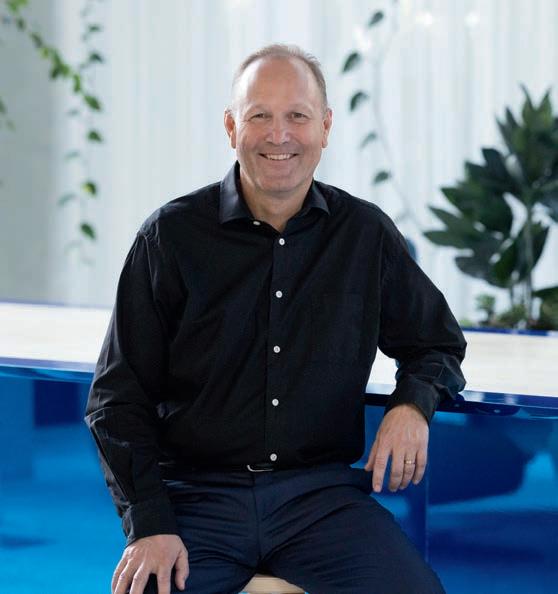
ing (just getting by) dropped by 6 percentage points to 23%, while most businesses (53%) said they were reviving (getting things back on track), and 17% said they were thriving (stronger than we have ever been), up from 14% last year.
Other measures of optimism and outlook have stayed consistent
from last year, as business leaders acclimatise to the new normal. 41% of business leaders said they were feeling about as optimistic as they were last year, with nearly a third (32%) feeling more optimistic than in 2022. Half of businesses anticipated that their revenue would grow in the next year, a steady
result from the 2022 study.
The study shows that effective use of technology is one of the best predictors of business success. Businesses use of digital technology to improve productivity aligned directly with their reported performance with 76% of thriving businesses saying digital technology improves their productivity, compared to only half (50%) of surviving businesses saying the same.
Fairgray says the report paints a picture for businesses looking to get ahead.
“In this inflationary environment, the best way for businesses to move the dial is to increase their productivity and deliver more value with the resources they have.
“Attracting and holding onto the best staff will be top of the list for most businesses, and making sure that modern technology tools are reducing friction and adding value shouldn’t be far behind.
“The combination of these two factors will be how businesses can set themselves apart and thrive long term.”
2degrees.nz/business/ shaping-business-study
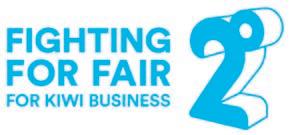
From first-time investors through to seasoned professionals, it’s difficult to know what investment types are the best fit for your goals. With interest rates rising, many investors are leaning towards term deposits – but are they really the best choice?
We’ve compared three different investment types across the risk spectrum, to help you determine what might work best for you.
Term deposits are familiar to many and easy to understand and obtain, making them a common investment choice. Their attractiveness is only improving as interest rates rise.
However, their lack of liquidity is a significant drawback, meaning an investor’s capital is tied up until the deposit matures, or they may face a penalty for early redemption.
Investors should also be aware of the impact of inflation on the purchasing power of their term deposits over time, especially when the rate of inflation is higher than the interest rate they are receiving on the term deposit.
Similar to term deposits, fixed-interest securities (also known as bonds) offer an opportunity to earn interest through coupon payments. Unlike term deposits, they are tradable, allowing investors to sell them for cash when needed.
Tradability gives investors greater flexibility and allows them to respond to changes in their financial circumstances or market conditions.
As tradable assets, bond prices do fluctuate when market interest rates move up or down. This can then lead to capital gains or losses for the investor if sold before maturity.
Market-driven price changes introduce both an element of risk and the potential for greater returns.
The coupon rate for each bond is determined by several factors,

> BY DEV ACHARYA
Dev Acharya is Vice President, Research Analyst of Jarden Securities. He is part of the research team supporting Jarden’s Tauranga-based wealth management advisers.
KPMG Tauranga’s Workplace Giving Programme has donated just under $5,000 to two Bay of Plenty charities, through the Acorn Foundation.
KPMG staff members involved in the giving programme chose to split their donation between local charities working in the fields of youth and education. The chosen charities are Te Aranui Youth Trust, which supports vulnerable children in the Western Bay of Plenty, and NumberWorks’n’Words Tauranga, which provides maths and English tuition after school to students.
Tanya Grimstone, funding manager at Te Aranui Youth Trust, says the donation has already allowed the charity to provide vital support to vulnerable children.
“This funding has already enabled us to assist two rangatahi [youth] who have been victims of family harm, with one school uniform so a child can return to school and also helping to replace a broken window to keep a home warm. Without these funds we would not have been in a position to help,” said Tanya.
Leanne Rhodes-Robinson, owner of NumberWorks’n’Words Tauranga, says the donation will provide four free tuition places to children who would otherwise not be able to afford a place.
“This funding will make a big difference to four students from lower socio-economic backgrounds, and we are so happy we can offer these places for free next term.
including the issuer’s credit rating, the time to maturity, and the prevailing interest rates.
A balanced portfolio, which is a mix of cash and bonds (income assets) and equities (growth assets) is another option to consider. Some investors may be uncomfortable with the risk associated with equities. However, by incorporating a mix of income and growth assets, a balanced portfolio offers investors the opportunity to access greater returns through equity exposure, whilst mitigating some of the risk associated with those assets through diversification.
A balanced portfolio is suitable for an investor who has an investment timeframe of more than five years.
In the event of an unforeseen change to an investor’s financial situation, the assets can be sold at market prices.
So, what’s the best strategy?
The table above provides a yearby-year performance comparison of a term deposit portfolio, a fixed interest security portfolio, and a representative balanced portfolio (40% income/ 60% growth), from 2005 to 2023. Over this time, the balanced portfolio outperformed the other options 12 out of 18 times. The term deposit portfolio and the fixed interest security portfolio were the top performer three times each.
These figures illustrate the steady, yet more modest returns generated by the term deposit portfolio and the stronger but more volatile returns of the bal-
anced portfolio. This comparison underscores the risk-return tradeoff – while increased potential returns can be accompanied by increased volatility, a balanced approach can help manage this dynamic.
Every investor will be seeking a different outcome from their investments, it all comes down to your personal investment goals and tolerance to risk. Whilst rising interest rates typically make term deposits a safe investment choice, investors looking for greater returns over the longer term shouldn’t overlook the potential benefits of a balanced investment portfolio.
Please contact your local Jarden Adviser if you would like advice on what strategy would be the best to help you achieve your goals. You can reach our Tauranga team on +64 7 834 2727.
“We are very grateful, as I know the children and their parents will be,” says Leanne. This is the third consecutive year that KPMG Tauranga’s Workplace Giving Programme has donated to local charities. Employees at the firm can choose to join the programme by donating a percentage of their payroll each month, which gets pooled, and the participating employees collectively decide where to donate their pooled money.
Lori Luke, Acorn Foundation CEO, says Workplace Giving is a popular model in the US, and gaining popularity in NZ.
“It’s a great way to bring employees together, as it’s inclusive – everyone can participate. The focus is more on participation than the dollar amount of individual contributions. And then you get this wonderful sense of collective achievement, where employees can really get a sense of the impact of their giving.”
KPMG is one of several corporate donors in the region who regularly give to the community in different ways through the Acorn Foundation.
Tanya Grimstone



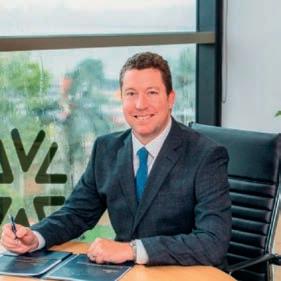

> BY NICK KERR
Nick Kerr is regional manager for Debt Free and director of International Private Investigations Ltd. He can be reached on 021 876 527 and nick.kerr@debtfree.net.nz
hen people learn of my various work activities such as high-risk repossessions, fraud investigation, legal document service and business credit consulting, they often ask me what the hardest part of my work is.
The answer may surprise you, as it often does them; It is not being threatened with weapons, having dogs set on me, dealing with violent and erratic meth goblins or being constantly insulted by angry debtors; the hardest part of my work comes from the business credit consulting where I have never been threatened, assaulted, insulted or bitten, at least not yet.
The reason is that for nearly two decades I have watched business owners repeat the same actions, leading to the same pain over and over again. This despite their having access to the information, tools and proven solutions that can remedy it and often prevent it from ever happening again.
As a father I liken this to watching a child run on to the road, being narrowly missed by a speeding car, being rescued, having the dangers explained to them and being sternly warned, then watching them run back on to the road to dance with the traffic.
I find this so hard because
I have seen hundreds of business owners suffer through liquidations, company collapses, voidable transactions, soul destroying litigation and the decimation that this causes them, both professionally, and more importantly, personally.
I have personally seen this result in suicides, family unit implosion, imprisonment and destruction of mental health.
In many of these cases I have met with the business owners (I have met with over 13,000 in my career) a year or two before the catastrophe occurred and spelled out to them in relevant and specific detail what can happen and exactly how to avoid it , shown them how to use the tools in a
business-friendly and cost-effective manner, only to have them say, “well it hasn’t happened to me yet – I will let you know when it does and then we can look at what you are saying”.
This is akin to saying, “yes, I know that I have no fire insurance on my house, once I smell the smoke and see the flames I will put some cover in place.”
By this time you will have nothing left to insure and the call will just be a waste of everybody’s time.
My desire for businesses to be protected from a credit management perspective does not come from some desire to make money at others expense, or to be right, or to be seen as some kind of business guru – it comes from literally hundreds of gut-wrenching phone calls from people I have met with asking me to assist them in remedying something that I could have helped prevent from ever happening.
Now maybe it is me. Maybe




For nearly two decades I have watched business owners repeat the same actions, leading to the same pain over and over again.”





I am not always effective in conveying the risks, despite having empirical data and relevant, real-life experience to prove my point. Maybe this is a failure that I must own.
I have spent my professional life upskilling, studying, gaining access to top experts and the most effective credit management tools available,




doing everything I can to be the most effective advisor I can and serve those that allow me to do so.
I’m not asking business owners to trust in me alone, trust the facts. The risk is not subjective when it is proven.
Read the paper. Watch the news. Google “liquidation” in the town that you live in.





These are not fairytales; they are records of recent history and each one is a document of real pain and loss. Do your research, find someone you can trust who knows their rear from their elbow in this regard, and for goodness’ sake, listen to them! Rant over. Just a thought.
Business owners and employees are being betrayed. Unless rapid action is taken, they face the risk of massive losses. This betrayal is sabotaging their careers, businesses, health and relationships. Could you be the next victim? The unfortunate truth is … you already are.
Everyone believes it will never happen to them.
But those are usually the people who will be hurt the most. You are being betrayed at your workplace, and in your home.
This ongoing erosion of trust is costing you time and money every single day. Unless something changes, this betrayal will also cost you your relationships, health and reputation.
You won’t spot the warning signs until it’s too late. And a sad truth is that a large number of professionals go to their graves without ever realising just how deep the betrayal ran. But who would do such a shallow and damaging thing to you?
You probably have someone in mind right now. No, it’s not them. At least, not this time. The person who is betraying you … is you. The confession
How are you betraying yourself?
The answer is simple: You’re pretending to be someone you’re not. Before you start getting too triggered and run to BOP Business News towers to burn effigies of me, please allow me to make a confession:
I was the ultimate artist of self-betrayal. I created a highly successful career advising the

leaders of the biggest brands on the planet … but that success was built on the back of a lie. No laws were broken, obviously. Unless you count the universal laws of authenticity. However, I was betraying myself, and those around me, because I was trying to be someone I wasn’t. Like an actor in a corporate pantomime, I dressed, spoke,
behaved and even thought the way my ‘character’ was supposed to be.
Did it work? Sure. Did it make me successful? Too right. Did it make me money? Absolutely.
It would be so perfect, had it not been for the fact I was betraying myself. I was being the exact opposite of the person – and the leader – I wanted to be.

> BY FREDDIE BENNETT
Guinness World Record Holder, podcast host and bestselling author, Freddie is known as ‘The Profit Hunter’. He helps business owners enjoy more time, money and freedom by discovering and extracting hidden profits in their companies. Freddie@conqueryourmedia.com
… but it’s the money that gets you out of bed.
My goals didn’t happen until I changed my behaviours.
No matter how professional or ‘together’ we try to appear, our thoughts and actions betray us.
As the sayings go…
Never trust a skinny chef.
Never trust a broke accountant.
Never trust an obese personal trainer.
Never trust a lawyer released from prison.
Your actions and behaviours are like a walking billboard, showing the world what you think about yourself.
More often than not, these behaviours are sabotaging your goals and your talent.
You tell the world: “I pride myself on being a good communicator” … but you won’t say, “No”.
“It’s important to take decisive action” … but you won’t back yourself to make a big decision.
“Family comes first” … but you spend the evening with your phone, not your children.
“I really want to love myself” … but you never invest in yourself.
“I’m an inspirational leader” ... but you let the people distract you from the problem.
“It’s not about the money”
When your behaviours are not in alignment with your vision and values, you make less money, have less fun and enjoy less connection and fulfilment.
So why do you do it?
Love the way you lie
We choose to let our actions betray our values because we fear the risk of shame that comes with being our authentic selves. Plus, we prefer to live in comfort and take the ‘easy’ option, even if it isn’t aligned to our personal values and philosophies.
Why stay true and stand out when it’s easier to follow a lie and blend in?
There’s no point in torturing yourself with a goal you’re not achieving if your behaviours are not congruent with your desires.
It’s like when I used to tell the world I’d be an athlete with a Guinness World Record to his name… but I was living on a Marlboro and vodka-based diet.
I told my clients to trust me, but I couldn’t even trust myself around an unattended birthday cake in the office kitchen.
Staying true to yourself
Self-betrayal happens when you do things the wrong way round. You tell yourself you’ll start to be that bold, confident, outgoing, trustworthy, disciplined version of yourself once you achieve that next level of professional success. But the opposite is true. You only achieve the professional success (and the personal success, for that matter), after you become that version of yourself.
To stop betraying yourself and start living in line with your personal values and philosophies, understand that success is the outcome of change, not the catalyst. So change trajectory: start acting in alignment with who you want to be. Look at your career, business, family, finances, health and fitness. Ask yourself: “Are my thoughts, actions and behaviours aligned with the outcome I want?” Stop living in delusion. Start making a difference. It’s time to be who you always said you were going to be.
If you have a family trust in New Zealand, recent news might have caught your attention. The trustee tax rate is set to increase from 33% to 39% starting from the 2024/25 tax year, which generally begins on April 1, 2024. This may come as a surprise to the 400,000 registered trusts in the country, especially since it comes under a budget that was supposed to have ‘no major tax changes’.
For those who utilise trusts for asset protection, which is common among small business owners in New Zealand, this change could have substantial implications.
The proposed changes
The trustee tax rate increase is a part of the Taxation (Annual Rates for 2023-24, Multinational Tax, and Remedial Matters) Bill. Along with this rate increase, the Bill introduces three additional changes related to trusts:
1. A 12-month exemption from the 39% rate for deceased estates. During this period, the estate will be taxed at the personal tax rate of the deceased person.
2. Trusts settled for the care of a disabled person will be taxed at the disabled beneficiary’s personal tax rate.
3. Income received by certain close company beneficiaries of trusts will not be taxed as beneficiary income
in the company but will be treated as trustee income with tax paid at the higher trustee rate. This aims to prevent trusts from distributing income to closely connected companies to take advantage of the lower 28% tax rate instead of the 39% trustee rate.
The trustee tax rate increase follows the prior increase of the top personal tax rate to 39% from April 1, 2021. At the same time, significant trust disclosure requirements were introduced, adding more complexity to the tax landscape.
Following the gathering of information and reviewing the behaviour of taxpayers over the intervening time, the Government justifies this trust rate increase with the argument that high-income earners might be utilising trusts to circumvent taxation at higher rates.
The Government maintains that only a small percentage of trusts will shoulder the bulk of this tax increase.
According to the Budget Press Release, the top five percent of trusts accounted for 78% of all trustee income in the 2021 tax year, estimated at $13.3 billion out of $17.1 billion, and the increase is projected to generate approximately $350 million in tax revenue annually.
However, this explanation might offer little comfort to the numerous trusts held by regular New Zealanders who personally pay tax at 33% or a lower marginal tax rate.
Data from Inland Revenue indicates that there are around 120,000 trusts with trustee income ranging from $1 to $180,000. The average trustee income for these trusts in 2021 was $21,000.
For these trusts, the tax increase to 39% could translate to an average increase in tax payable per trust of $1,260, which collectively could amount to a significant $151.2 million extra tax burden, all things being equal. This has led to calls for a two-tier tax
This year’s distribution from the Acorn Foundation sees $3.3M given to the Western Bay of Plenty community. It is Acorn’s 20th year of supporting local charities on behalf of generous donors. If you haven’t yet considered the legacy you would like to leave locally, Wills Month in September is the ideal time to organise your wishes.
Gifts given through the Acorn Foundation are invested in perpetuity, generating investment returns that are distributed annually to community organisations working in areas that are closest to donors’ hearts. If you choose to set up a legacy fund, your donation can be invested and grown into a long-term source of funding for your local community.
The invaluable support from local businesses plays a huge role in Acorn’s ability to continue its vital role in our community. Acorn Foundation CEO Lori Luke says, “Our thanks go out to all of the local businesses who support us –and our community – via workplace and corporate giving, as well as the law r s who partner with us for Wills Month.”
During Wills Month 2023, 16 local law o ces across the region
have o ered to add a gift to the co unity through Acorn to their clients’ wills for free.
Participating law r s include Abernethy Broatch Law, Anderson Law O ce, each Law Papa oa, urley astle Hawkins Lawy, Cooney Lees Morgan, Fenton McFadden, Harris Tate Lawyers, Holland Beckett Law, Kaimai Law –Bethlehem, Kaimai Law – Katikati, Keam Standen Lawyers, Rejthar Stuart Law, Sharp Tudhope Lawyers, The Mount Lawyers, Tompkins Wake and Toner Law.
For more information go to www.acornfoundation.org.nz


>
BY ANDREA SCATCHARD
Andrea Scatchard is a Tax Partner at Deloitte, based in the Bay of Plenty. She can be contacted on ascatchard@deloitte.co.nz

rate for trusts, where those with income under a certain level (such as $180,000) would only pay tax at the current 33% rate.
A word of caution
Trustees that are considering what impact this proposed change will have on them and their beneficiaries would be wise not to make any immediate decisions regarding changes in the distribution
of income or reorganisation of investment structures. Not only do we not know the final version of any changes, as the consultation process may impact this, but it is possible that the changes might not proceed at all as any new Government will need to reinstate the draft legislation (or not) following the election.
Aside from the impact of any tax rate change, before making any changes trustees should consider their respon-
sibilities to the beneficiaries of the trust under trust law as well as whether any restructuring or changes in distribution policy could be considered tax avoidance. As we saw following the increase in the personal tax rate in 2021, any change in taxpayer behaviour in light of tax rate changes is likely to attract Inland Revenue attention so trustees are advised to seek both professional legal and tax advice before proceeding with material changes.
Around the world, rising interest rates, high inflation and geopolitical risks are backdropping a more challenging and volatile business environment.
Bayleys’ global real estate partner Knight Frank says in its latest The State of Logistics: Asia-Pacific Focus Report 2023, the logistics sector’s strong fundamentals will ensure its resilience in the face of these challenges despite an easing of “just-incase” inventory management strategies that emerged during the pandemic, and lower online transaction volumes.
When supply-chains were fractured, there was frenetic competition for institutional-grade logistics assets as larger occupiers acquired more space than normal in anticipation of more consumer demand for products which in turn, drove rental growth to record levels.
Vacancy remains tight and rents keep rising
In the New Zealand context, Bayleys’ head of insights, data and consulting, Chris Farhi says coming into 2023, there was a prevailing sense that the pressure might be coming off industrial rents and that demand for warehousing space could be pegged back, but this is yet to transpire.
“Because of the general slowdown in the economy and the fact that by the end of last year, commentators were widely tipping that New Zealand was heading into a technical recession given GDP indicators, those at the coal-face of the industrial market were anticipating rental rates to stabilise,” says Farhi.
“Additionally, we thought that with supply chain dynamics settling down, and the ‘just-in-case’ inventory stockpiling that we’d seen in the market for a couple of years likely to tap off, some of the pressures on warehousing could start to resolve.
“However, vacancy levels are still
exceedingly tight with pent-up demand for space and this has driven industrial rents to unprecedented levels”.
Farhi says any new supply to the market has pushed average rental rates up as landlords look to offset escalating construction, and financing costs and with higher yields putting downwards pressure on valuations.
“The development feasibility matrix has been crushed from all angles and industrial occupiers looking to rent brand new stock could be taken aback at the going rate – particularly if their existing lease had not been reset to the market for some time or they were looking to upgrade to state-of-the-art premises with optimal sustainability and amenity credentials.
“Developers are more cautious in the current environment and are carefully weighing potential returns against heightened risks.”
Bayleys’ national director industrial, Scott Campbell says benchmark rents have been persistently growing for industrial stock across most of the major centres.
He says landlords have the advantage in the current market and this is not likely to change given the unrelenting squeeze on space and exacerbated by a decrease in the number of industrial building consents issued for new stock.
“As long as high inflation exists and interest rates keep rising, rents will rise, so tenants have to accept rental escalation because there’s actually very little they can do to stem the tide given the main common ground between property owners and occupiers is one party owns the space, and the other party needs space.
“Bayleys’ tangible point of difference in the market is the amount of deal flow through our leasing network and the fingers we have on the market pulse which shows not just how
The industrial rental ball is firmly in the landlords’ court as occupiers strategise space requirements.

quickly stock is being absorbed, but reveals a line of tenants waiting in the wings.
“We’re looking at how rental rates are tracking and monitoring transaction times, and frankly the speed at which properties are leasing is astounding – particularly when compared to other sectors like office, for example, where despite reasonable demand, the timeframes for leasing tend to be more drawn-out.
“We’re talking weeks not months for industrial space, with multiple viewings, and many agents reporting that they are effectively running waitlists for space.”
Campbell says while construction costs may have stopped rising at the levels seen in the last couple of years, they’re still elevated.
Wage costs are still increasing and the cost of debt remains high so developers are understandably hesitant to progress new projects, despite low nationwide vacancy levels.
“Realistically, land costs would have to drop to make the development equation stack up for a developer in the current climate.
“Recently completed new-builds in the major centres are commanding premium rents that are significantly higher than existing rents, and occu-
piers may have to start looking for space outside of their core area to get cost efficiencies from more affordable space.
“We also note a differential in rental rates between prime and secondary stock of around 10-15 percent, and with occupier sentiment placing increased emphasis on sustainability credentials for operational efficiencies and other ESG-driven initiatives like staff well-being, landlords are accepting that they will have to refurbish secondary-grade facilities to mesh with occupier strategies.”
Savvy budgeting required
Campbell says occupiers that are renewing leases are all facing rent hikes and must do diligent forward budgeting to reflect these escalations and establish where the likely new lease term range may be as inevitably, it will surpass the levels that might be forecast through generic budgeting analysis.
“All leases today are being structured to factor in rental increases whether via annual fixed increases, benchmarked to CPI or market or a combinations of these rental growth mechanisms, with landlords being far more astute about market rent reviews
and with no need for tenant incentives given the demand-supply dynamics.
“For new leases, occupiers should expect 3-4 percent annual growth over the term of the lease and those seeking new premises should have a clear exit strategy, brace themselves for competition and be prepared to commit quickly.
“While we haven’t seen evidence of rental auctions, this has merit for landlords as naturally they are looking to extract as much rental as they can for a property while effectively balancing risk through longer lease terms.
“We did see a ‘best-foot-forward’ deadline leasing campaign for a property last year and it remains to be seen whether supply stresses will see this emerge as a market trend.”
Capacity for rental growth remains
“In some instances, occupiers are prepared to lock in a lease for a site with scale, then sublease components until they grow into the space if their lease agreement allows this,” says Campbell.
“Businesses that are anticipating growth are proactively building future capacity into their hunt for space and in that regard, there’s a distinct advantage in leasing space from a landlord with a broad portfolio given they have ability to move occupiers around to right-size space.”
Campbell says while it’s not what occupiers want to hear, rents are unlikely to drop. “They may plateau but we can’t find a good supporting reason for rents to go down.
“However, as the world resets and supply chain logistics have more certainty around them, some normalcy should return to inventory held by some businesses so those occupiers that no longer need to hold high levels of stock may start shedding some space which could take some pressure off available supply.”

By ALAN NEBEN
There’s more to car sharing than you probably realise. There is certainly a lot more to it than I realised: what an eye-opener the experience was for me when I decided to take up the offer of using the GoTo Car Share service for the day recently.
I’m used to landing at an airport, showing my license, filling in forms, handing over my credit card and being told to check carefully for damage and then wait when hiring a car – the GoTo experience had an entirely different feel.
For one thing, the hard [easy] work was all done on-line the night before and although I was dubious about the need to download the user app, I did so that night.
Thank goodness I did because there were no keys to pick up, no forms to sign, no fuel tank to check … no stress.
Just a booking and a start button on the app.
I booked a Tesla online for six hours, confident I would have all my errands done, the vehicle dropped back and plugged in on-time by 3pm. Although I made a point
on the day of catching up with the company’s founder Steven Vincent for a run-over their car share offering and operation, my next booking simply won’t require any human contact at all – I’ll book on the app, turn-up, unlock via the app and drive away. Yup, that easy.
I’m certainly not anti-social (I don’t think), but there’s something quite empowering about not needing to queue, wait for a human, form-fill and go through the niceties of a chat about the weather and the traffic congestion when you’re in a hurry.
GoTo Car Share offers a range of electric vehicles to choose from – all from the app; for those needing a car for deliveries around town for the day, the Nissan Leaf’s small form and low tariff may be just the right fit.
On the other hand, the manager visiting from out of town, or the consultant you agreed to provide with an executive vehicle for a couple of days may be better suited to the MG ZS or the Hyundai IONIQ.
However, I was going to travel a few kilometres and I wanted a bit of ‘wow’ factor for the day, so I booked a Tesla
GoTo Car Share offers a range of electric vehicles to choose from – all from the app; for those needing a car for deliveries around town for the day, the Nissan Leaf’s small form and low tariff may be just the right fit.
Model 3 (I have a confession to make: this was my first full day in a Tesla and deep down I found it all quite exciting).
I jumped in and was pleased to immediately see a ‘full charge’ on board – just short of 400km available to me – that eliminated any range anxiety, though I double-checked and there was a fob for rapid charge on the run from the public network if needed during the day – all provided without any fuss and bother.
Like many of you, although I have had some good car hire experiences over the years, I have unfortunately also had my share of bad ones: vehicles unavailable, an expired-driver’s-license-surprise in a foreign city, ghost credit card charges appearing a month after hire, poor customer service, long queues, waits for car servicing, over-the-top car refill and mileage instructions and general treatment akin to that of a shoplifter in a charity store.

> BY NATHAN BONNEY
Nathan Bonney is a director of Iridium Partners. He can be reached at nathan@iridium.net.nz or 0275-393-022
have finally placed my finger on the analogy for a background-setting or stage on which New Zealand’s SME owners (including franchisees and franchisors) have had to act on over the past 2-3 years.
It is Samuel Beckett’s play Waiting for Godot.
If you are not familiar with the work, two weary characters, Vladimir and Estragon find themselves aimlessly awaiting the arrival of Godot.
As they await a neverending variety of misfortunes and misadventures become characters, unbelievable characters pop up and absurd time wasting and pointless conversations, exchanges and exercises take place.
If we expand the analogy, the part of Godot has been played by the Labour Government.
We’ve been told and promised that things will get better, that Godot is on the way. In the meantime, nothing sensible happens.
In the play, in spite of continual hoping that he shall arrive, and their situation will improve, Godot never arrives. The central theme is promised salvation, to be delivered by Godot.
For business in New Zealand the waiting has meant enduring misfortunes including Covid-19, interest rate hikes, recession, labour and supply challenges, climatic disasters and of course the central and continuing theme: a government and political setting unsympathetic to business.
In one particularly pointless scene of Waiting for Godot, the two main characters play a version of the shell game with three identical hats, each asking the others each time they are passed, “which one looks better on me?”
I couldn’t help but think watching this recently that it looked very much like a Hipkin’s government ministerial appointment process.
Waiting for Godot is often described as a play in two parts, in which nothing happens, twice.
It’s uncanny that we’re witnessing the second act, in a further twist of similarities: we have had a new Prime Minister and government claiming to be different to the former, when of course they are one and the same.
But, they ask us to continue to Wait for Godot, that after six years, they have the policies and ability to change; they say, “Mr Godot has told me to tell you he won’t be coming today, he’ll be here tomorrow”, so vote for us, again.
But unlike the play and it’s characters, whom don’t know if they are happy or not, New Zealand now understands the play and situation in which they have been thrust and are looking to write the next act differently.
No more Waiting for Godot. That we can (impatiently) wait and look forward to.
The GoTo Car Share model has eliminated all that negative baggage – the GoTo experience for me on 22 August was simple and enjoyable – the pick-up base in central Tauranga was a per fect location for me on the day, and the quick orientation and car once-over was easy.

I knew from my app what the charge for the day was going to be – the easy to calculate base hourly rate is capped for certain time periods, meaning no nasty surprises if you need to change plans or be fluid during the day.
You also have the flexibility of hiring from 30 mins to all day, weekends or longer. In my case, come 1pm, I knew it was going to suit me better to keep the car for an

extra hour until 4pm –how wonderful to be able to extend the booking from the app there and then at a minimal charge with no penalties (to be honest I didn’t ‘need’ the car for an extra hour, I simply ‘wanted’ to keep driving it).
I asked Steven Vincent about the trend to EVs in the car share space: “GoTo Car Share is simply following a trend overseas for practical, convenient, affordable EV car sharing right here in the BOP.”
“We make a point of ensuring we have good accessible parking and quality charge facilities in Tauranga city.
You’ll never pick up a car here that’s not fully charged and ready to go.”
“I think that’s why we’re getting such a good uptake and regular repeat business, whether that’s executives looking for a Tesla to take to Auckland for an overnight trip, or small business using a Leaf for a half day to catch-up on a deliveries backlog – it’s cheaper than buying and maintaining a new pool car, it’s good for the environment and it just makes sense.” I have to add one more advantage to his list: “ … and it’s fun.”
For more information on GoTo Car Share go to www.goto.nz
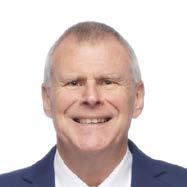
> BY STEVE CATLEY
Steve Catley is a Business Broker at LINK Business Brokers. He can be contacted at 021 341 117 and steve.catley@linkbusiness.co.nz
usiness owners and aspiring entrepreneurs will be glad to know that New Zealand’s current market offers a wealth of intriguing opportunities for buyers and sellers alike. Here are some strong trends and valuable insights to enrich our collective understanding of the prevailing business environment.
One of the most significant and relevant trends is the recent rise in buyer activity. We’re witnessing a steady increase in buyer enquiry levels month on month, which indicates an active and thriving business climate.
As a result, serious buyers are becoming more confident in their pursuit of entrepreneurial goals and are shifting their focus from traditional real estate investments to the acquisition of strong businesses.
The present market conditions offer a prime opportunity for sellers to achieve better results.”
Banks are playing a pivotal role in supporting these aspirations, with favorable lending conditions that facilitate acquisition, growth and expansion.
Timing is important when deciding to sell a business. A big mistake that sellers could make today is missing the window of opportunity they’re currently sitting in. Too often, sellers unfortunately focus solely on the dollar and misjudge the timing. The present market conditions
offer a prime opportunity for sellers to achieve better results due to the heightened competition among buyers. The time to act is now! For buyers, currently on a quest for the “perfect” business, the reality is it is likely to be a fruitless search.
The perfect business doesn’t exist. If you find a business that ticks most of your boxes, back yourself and proceed.
Successful entrepreneurs rarely look back and regret the price they paid for a good business.
With escalating levels of buyer enquiry, ready availability of bank funding, increased buyer competition, and rising business confidence levels, the stage is set for both buyers and sellers of businesses to achieve excellent outcomes in the pursuit of their business aspirations.
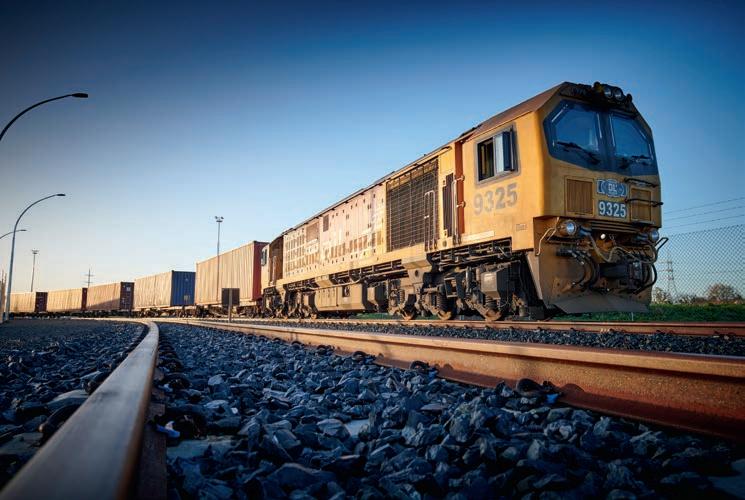

Ruakura Inland Port – a newly minted, 9ha customs-controlled cargo facility on Hamilton’s eastern boundary – welcomed its first two goods trains, one each from Tauranga and Auckland in August. The new $60m facility has been more than 15 years in development by Tainui Group Holdings, the commercial entity of Waikato-Tainui, and will be operated in a joint-venture with Port of Tauranga – for an initial period of 50 years.
Senior management representing the JV were on hand to mark the first train from Tauranga rolling into the twin 800m rail sidings just after 7am on 3 August.
Tainui Group Holdings Chief Executive Chris Joblin said the milestone marked an exciting new opportunity for importers and exporters, especially in the Waikato and Bay of Plenty regions.
“This is a big step towards reducing carbon emissions from the Upper North Island supply chain. It gives importers and exporters the option to move away from the previously ubiquitous round-trip, road-based journeys, towards more rail-based
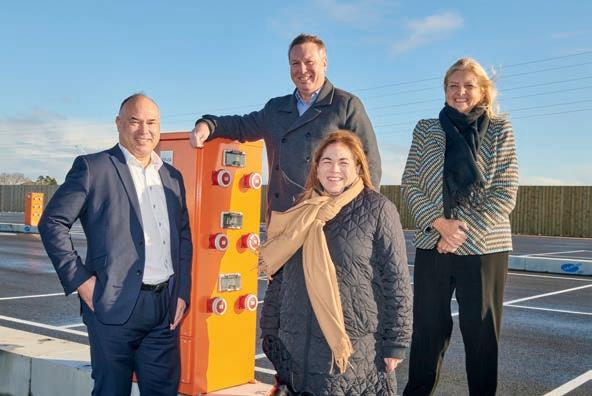
one-way movements for cargoes,” Mr Joblin said.
Recent modelling commissioned by the JV from independent supply chain experts has confirmed potential cost savings of up to 30% for cargo owners using rail from Ruakura Inland Port – compared to the roundtrip, road-served transport model from Hamilton to Tauranga and Auckland.
Initially, two trains a week, each capable of carrying around 90 containers called at Ruakura Inland Port as the inland port underwent final commissioning during August. Train calls will now be increased to match demand. KiwiRail operates more than 85 train services per week between MetroPort Auckland and Tauranga which pass through Ruakura.
This year will also see the opening of other large-scale businesses at the adjacent Ruakura Superhub. These include the 40,000m2 Kmart Distribution Centre, and new cold storage facilities operated by global player Maersk (16,000m2) and Big Chill (13,000m2), which will generate freight through the inland port.
Leonard Sampson, Chief Executive of Port of Tauranga says partnering with TGH to operate the inland port has delivered strategic infrastructure which will amplify the connectivity of the Port’s existing facilities.
“By combining Port of Tauranga’s expertise in developing and operating ports, with the deep regional connections of TGH, and the scale and efficiency of the Ruakura location we can deliver more value for our regions and customers,” he says.
Quality Marshalling Ltd (a 100% owned subsidiary of Port of Tauranga) will manage physical operations at the inland port.
The JV is forecasting to handle around 40,000 TEU1 transferred through the Inland Port in the first year of operations.
Peter Reidy, CEO of Kiwi Rail,
also welcomes the opening of this strategic node on the national rail network.
“It is not only an expansion, but a better utilisation of our national rail network. We believe that rail offers resilience against supply chain disruptions, and it is good to see increasing interest and use.
Importantly, this project shows an increased connectivity of our infrastructure to benefit cargo owners and consumers across the country to help decarbonise land transport in New Zealand.”
Chris Joblin of TGH sees the opening as a point of pride for the region’s economic infrastructure. “It is exciting to see another dot on the map for Hamilton.
This is the type of infrastructure to really cement the city’s importance in the New Zealand’s economic landscape. With Ruakura Inland Port operating and the adjacent Waikato Expressway, it’s an alignment of infrastructure that will deliver great value for our country, region and Waikato-Tainui,” says Chris Joblin.
1 TEUs = twenty foot equivalent units, a standard measure of shipping containers

> BY BEN CAIN
Ben Cain is a Senior Associate at James & Wells. He can be contacted at 07 928 4470 (Tauranga), 07 957 5660 (Hamilton), and ben.cain@jamesandwells.com
apturing the consumer dollar can be a challenge at the best of times. At the worst of times, such as arguably those New Zealand is experiencing at the moment, it can be even harder.
It is not surprising then that to maximise their chances of capturing the dollar, businesses might undertake what in legal speak is called comparative advertising.
That is, advertising in which either a business states that its products (usually) are compatible with another brand’s products, or a business compares its goods (or services) to the goods (or services) of one or more competitors, highlighting the benefits of that business’s goods over the competitors’.
The benefits might be lower price, greater value, better performance or durability, for example.
Done right, comparative advertising can be very successful, achieving brand switch and long-term loyalty. Just ask Whittaker’s and potentially Pak’nSave (Kiwis will know what I mean here …). Done wrong, and you can infringe registered trade mark rights (if you use a competitor’s trading name or logo in your ad) and/or breach New Zealand’s Fair Trading Act 1986 and Advertising Standards Code.
A well-publicised recent example of where a business ‘got it wrong’ in New Zealand involves the kiwi toy company, Zuru1, and the world famous
brickmaker, Lego2
Zuru had used the LEGO word mark on packaging for its own ‘MAX Build More’ toy bricks to advertise they were compatible with Lego branded bricks. Lego had not consented to Zuru’s use and, to cut a long legal story short, sued Zuru for trade mark infringement, passing off and breach of the Fair Trading Act.
Although it failed on its passing off and Fair Trading Act claims, Lego did succeed on its trade mark infringement claim on the grounds Zuru did not use the LEGO trade mark in accordance with honest practices in commercial matters and its use took unfair advantage of the LEGO trade mark.
Further, it was not reason-

ably necessary for Zuru to use the LEGO trade mark in such a prominent way on the front panels of its containers and packaging to indicate either a characteristic of its products or the intended purpose of its products.
Outside the world of toy bricks, I am aware of two
other recent examples where competitors have undertaken questionable comparative advertising.
Due to client confidentiality, I am unable to divulge further details.
It suffices to say however that when scrutinised, the comparisons – which involved
comparisons of product features – did not stack up: quite the opposite, the comparisons were fundamentally flawed and, should they have been tested in a court, would, I venture, been found so. There are, I perceive, four key ‘rules’ when it comes to comparative advertising:
1. If making compatibility statements, like Zuru, ask yourself (and sense check with others) whether using your competitor’s name or logo is really necessary. A good rule of thumb might be, ‘If in doubt, leave it out’;
2. If comparing goods or services, compare apples with apples, not apples with pears and, worse still, lemons;
3. If you are questioned, make sure you can wholly justify the claims you make in your advertising; and
4. If you are in any doubt, seek appropriate legal advice. Forewarned is forearmed.
Ioften talk a big game. “Bike lanes are brilliant.” “Buses are so convenient.” “EVs –yeah, they’re our future.”
Yet I’ll admit it, ‘I’m a fraud’.
I haven’t caught a bus to a weekday meeting in years. I’ve never driven an EV, let alone bought one.
Although I ride my bike regularly over the summer, I’m a fair-weather cyclist and over winter I get lazy and drive.
So, when I found myself arguing recently with my old-school ‘petrolhead’ mate Steve that EVs are better, and cleaner, and faster, and quieter, and cheaper, and cooler … he called me out.
“What are ‘you’ driving then,” he asked? “Or did you come here on your e-bike, or by bus?”
I’d driven to meet him in my Nissan (internal combustion engine – ICE). A good car. A great car. But a dirty petrol-engine job nonetheless.
Immediately I was fully exposed as an out-and-out fraud and no excuse seemed plausible.
The excuses I contemplated proffering were all, quite honestly, pathetic.
“I’m too busy to bus.” “I’m different from other people –


> BY ALAN NEBEN
Alan Neben is a Mount Maunganui local and experienced New Zealand publisher. His columns provide a light-hearted perspective on social changes effecting New Zealanders.

my schedule changes often and I can’t cope with range anxiety.” “You can’t trust the weather forecast.”
Instead, I went silent.


The challenge

That evening I decided to get off my lazy arse and make an effort – I pledged to not comment again on alternative transport modes until I’d actually used them. I think we are all irritated by the opinionated loudmouth who always seems to have a negative comment about things he or she has never experienced.





OMG, I was that guy, though in my defence, my comments about things I’ve never experienced are generally positive (rather than negative); deep down there’s a Freudian









for acceptance on my part. Come the following Saturday morning, the born-again me emerged.
Diary of low-emission alt transport convert
Saturday – return bike ride
Mount Maunganui to the Lakes, Tauriko – 21kms each way; Sunday – this one was a biggie for me – apply online for a Bee card (for the uniniti-

SOLD; Wednesday – Bus, bike and scooter throughout the day. Thursday – Walk to meeting. Walk home; Friday –Celebrate two weeks car-free.
Highlights
start a business trip.
• I feel more alive when I get fresh air and exercise.
• It feels good to be doing your part to save the planet.
• EV’s really are cool. Really.
• Riding a Lime Scooter is good for the soul.

ated, that’s a local bus card) and download the Transit app; Mon– Lime scooter to two local meetings, though cautiously terminating each trip well out of sight of colleagues at the final destinations: I’m not stupid, my dismounts never look ‘cool’; – Uber to and from business seminar and cocktails across town; Friday – Catch bus from Mount Maunganui to Tauranga. Meet friends. Drink cocktails. Catch bus home; Monday – Attend client presentation in Hewlett’s Road by Lime Scooter. Wearing lightweight shirt scooter home late and freeze; Tuesday – Catch bus to Tauranga and pick up GoTo Car Share Tesla for road test.



• Passing queues of stationary traffic while riding a Lime Scooter one way, and via a bus lane on the way back – priceless
• Checking my Transit app to find out there’s a bus due at my front door in three minutes – yes!
• Stepping off the bus in Willow St and taking eighteen steps into one of my favourite tap houses – nice
• Not needing to find a park there – nicer
• Taking a three-minute detour on my bike ride home from a morning meeting to check out the surf – paradise
• Riding from Mount Maunganui to The Lakes, Tauriko and only needing to ride on the road for two short stretches – awesome
Lessons learned
• I live in a beautiful part of the world: a bus ride via Pilot Bay on a sunny morning is a wonderful way to

> BY KELLIE HAMLETT
Talent ID are Recruitment Specialists and can support you through your recruitment process. Please feel free to talk to us about this by calling 07 349 1081 or emailing kellie@talentid.co.nz
he political landscape of New Zealand can have a profound impact on various aspects of our society, and the employment market is no exception.
The winning party(s) hold the power to shape policies to help achieve their distinct vision for the nation’s economic and social future. Potential changes to government spending, tax reforms, infrastructure investments, RMA reform, to name just a few, are all poised to influence the job market and the country’s economic conditions in multifaceted ways. These potential local changes coupled with continuing geopolitical tensions offshore, the emerging impacts of climate change, the significant slowdown in Chinese demand for our products and recessionary environments across the world certainly add an element of volatility and uncertainty to our NZ job market.
However despite this, we still consider that New Zealand has strong economic credentials, an independent Reserve Bank and, with low government debt, is as well placed as any country to weather coming challenges; the employment market, although likely influ-
enced in different ways by the election as outlined below, will remain, on the whole, strong. With regards to the upcoming election, it looks like it will be a tight race. However one thing that is apparent is the minor parties are much more likely to have a stronger influence than in the past, whether it’s the Greens and Te Pati Māori pulling Labour to the left or Act pulling National to the right. New Zealand is potentially going to experience a significant shift in its political landscape in the upcoming election.
If we look at the last two terms of the Labour-led Government, we have seen a number of policies impact the labour market. These include the increase in minimum wages through to $22.70 per hour, the 10-day sick leave entitlement, a new Public Holiday and support of more than 90,000 New Zealanders through free trades training and apprenticeships with the unemployment rate reducing from 4.8%-3.3%.
The Labour Government also introduced the accredited work force visa, which has had implications for employers and the candidate pool, which is very much short on skills, to an already struggling immigra-
tion department.
Let’s look at some of the political parties’ policies and plans moving forward for the 2023 election and how these may affect the employment market.
Labour – Our current Governing party has stated its next move is to back businesses to grow jobs and wages, continuing to offer free apprenticeships to fill skill gaps and with initiatives like the Regional Strategic Partnership Fund where they support industries to reach their full potential. They plan to create more jobs, including through investment in much-needed infrastructure projects.
National – National have a raft of policies on offer, one of the key ones is tackling inflation. With a five-step plan including reducing unnecessary costs to employers, business and the productive economy and reducing bottlenecks in the economy, specifically the immigration policy mess causing New Zealand to lose skilled workers and making it too hard for businesses to welcome desperately needed staff.
National appears currently to have a real shot at being able to form a coalition government with Act after the election and
if they do, as they say they will, this might lead to increased economic activity, potentially translating to job creation in export-oriented sectors.
Green Party – With their polling numbers increasing they could have significant influence on Labour if Labour wins enough seats. Their policies revolve around climate and a greener more sustainable New Zealand.
The renewable energy sector is likely to benefit from a focus on sustainability, leading to job growth in roles related to clean energy production and technology.
The Green’s climate plan will create jobs, and they plan to provide training opportunities and secure work for people moving out of carbon-intensive industries. Given this is a relatively new industry and some of the initiatives they are talking about are still in their infancy, this will take time. It is definitely an industry to watch and the employment market could experience a transformation in skill requirements in the long-term as is happening across many other nations.
ACT Party – With strong polling numbers, ACT looks likely to have a major influence upon a National-led government if that comes to fruition. They have a plan to cut red tape, grow the health workforce, support farmers and introduce a tougher sentencing stance. This will grow roles in these industries, but again predominantly relates to bringing in international talent. Cutting the red tape will likely
• Sunny weather makes biking far more enjoyable.
• Don’t bike 40kms in a day unconditioned and expect your rear end not to hurt.
Questions
• Why are there not more people on the bus?
• Will petrol stations be replaced by charging stations soon? When?
• When will Steve admit that EVs are better, and cleaner, and faster, and quieter, and cheaper, and cooler?
Verdict
• My next car will be an EV.
• I’m still not convinced I’ll bike in the rain … but watch this space.
• I will keep using the bus –it’s not just for school kids and retirees.
I’m no longer a fraud, and I feel all the better for it. Let’s talk multi-modal – it’s my thing now.

reduce some roles in the public service and their desire to cut government spending will potentially come by way of cuts to public service wages, which have been on a freeze until recently. These are due to be aligned with the current market. Another of ACT’s plans is to rollout toll roads across the country to help fix NZ’s roading situation which, looking at the current state of our roads, won’t be a small project; looking into civil roles for long-term employment could be a great career choice!
Te Pāti Māori – Fiercely advocating for the interests of whānau, Hapū and Iwi in Government they may be in position to influence the likely winning coalition. The big push around gaining equality and better wellbeing for Maori will continue to see new opportunities for Maori in the employment market and upskilling opportunities to move generational families out of the welfare system, with overall improved outcomes for Maori Whanau.
NZ First – as we all know you can never count out NZ first and its charismatic leader Winston Peters who has a habit of being the kingmaker.
As their slogan says they are looking to take NZ back so we will have to wait and see what
that would mean if they are in a position to influence a future government.
While elections can inject uncertainty into the business environment, we continue to believe New Zealand’s longterm economic fundamentals are strong. With both National and Labour being largely centrist, the democratic process and MMP means change can be slow. While there may be some short-term uncertainty and cautious hiring practices could prevail, it will not be long until the business community gains confidence in the stability of new policies. With the election set for October, this may well bring a period of transition and potential growth in the employment market. While short-term effects may be seen in government-driven job creation and sector-specific adjustments, long-term impacts are likely to revolve around skills development, wage dynamics, and the nation’s global economic positioning.
The coming years will determine how successfully the policies translate into real opportunities for New Zealand’s workforce, while navigating challenges brought about by global economic shifts and evolving societal expectations.










